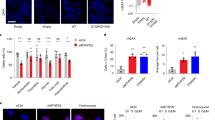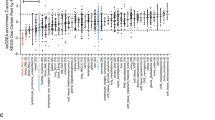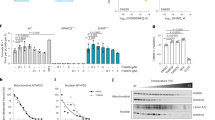Abstract
Children with acute lymphoblastic leukemia (ALL) diagnosed with resistant phenotypes, and those who relapse, have a dismal prognosis for cure. The antifolate methotrexate (MTX), a universal component of ALL therapies, is metabolized by folylpoly-γ-glutamate synthetase (FPGS) into long-chain polyglutamates (MTX-PG3−7), resulting in enhanced cytotoxicity from prolonged inhibition of dihydrofolate reductase (DHFR) and thymidylate synthetase (TS). Using DNaseI assays, we identified a hypersensitive site upstream from exon-1, suggesting chromatin remodeling could alter FPGS expression. We demonstrated that histone deacetylase-1 (HDAC1) is recruited by NFY and Sp1 transcription factors to the FPGS promoter in ALL cell lines. We examined the effect of histone deacetylase inhibitors (HDACIs) sodium butyrate and suberoylanilide hydroxamic acid (SAHA) on the expression of FPGS and other folate-related genes. HDACIs increased FPGS mRNA expression by 2- to 5-fold, whereas DHFR and TS mRNA expression was decreased. Combination treatment with MTX plus SAHA significantly increased cytotoxicity and apoptosis in B- and T-ALL cell lines as compared with each drug alone (CI⩽0.8). SAHA increased the intracellular accumulation of long-chain MTX-PG3−7. Therefore, HDACI-induced FPGS expression increases the accumulation of MTX-PG3−7 and cytotoxicity in ALL cell lines, which is potentiated by DHFR and TS downregulation. The synergism exhibited by the combination of MTX and SAHA warrants clinical testing in ALL patients.
This is a preview of subscription content, access via your institution
Access options
Subscribe to this journal
Receive 12 print issues and online access
$259.00 per year
only $21.58 per issue
Buy this article
- Purchase on Springer Link
- Instant access to full article PDF
Prices may be subject to local taxes which are calculated during checkout







Similar content being viewed by others
References
Pui CH, Evans WE . Treatment of acute lymphoblastic leukemia. N Engl J Med 2006; 354: 166–178.
Suh JR, Herbig AK, Stover PJ . New perspectives on folate catabolism. Annu Rev Nutr 2001; 21: 255–282.
Pui CH, Campana D, Evans WE . Childhood acute lymphoblastic leukaemia—current status and future perspectives. Lancet Oncol 2001; 2: 597–607.
McGuire JJ, Bertino JR . Enzymatic synthesis and function of folylpolyglutamates. Mol Cell Biochem 1981; 38 (Spec No): 19–48.
McGuire JJ, Hsieh P, Coward JK, Bertino JR . Enzymatic synthesis of folylpolyglutamates. Characterization of the reaction and its products. J Biol Chem 1980; 255: 5776–5788.
Moran RG, Colman PD, Rosowsky A, Forsch RA, Chan KK . Structural features of 4-amino antifolates required for substrate activity with mammalian folylpolyglutamate synthetase. Mol Pharmacol 1985; 27: 156–166.
Fotoohi AK, Albertioni F . Mechanisms of antifolate resistance and methotrexate efficacy in leukemia cells. Leuk Lymph 2008; 49: 410–426.
Baldwin SW, Tse A, Gossett LS, Taylor EC, Rosowsky A, Shih C et al. Structural features of 5,10-dideaza-5,6,7,8-tetrahydrofolate that determine inhibition of mammalian glycinamide ribonucleotide formyltransferase. Biochemistry 1991; 30: 1997–2006.
Jackman AL, Taylor GA, Gibson W, Kimbell R, Brown M, Calvert AH et al. ICI D1694, a quinazoline antifolate thymidylate synthase inhibitor that is a potent inhibitor of L1210 tumor cell growth in vitro and in vivo: a new agent for clinical study. Cancer Res 1991; 51: 5579–5586.
Barredo JC, Synold TW, Laver J, Relling MV, Pui CH, Priest DG et al. Differences in constitutive and post-methotrexate folylpolyglutamate synthetase activity in B-lineage and T-lineage leukemia. Blood 1994; 84: 564–569.
Whitehead VM, Rosenblatt DS, Vuchich MJ, Shuster JJ, Witte A, Beaulieu D . Accumulation of methotrexate and methotrexate polyglutamates in lymphoblasts at diagnosis of childhood acute lymphoblastic leukemia: a pilot prognostic factor analysis. Blood 1990; 76: 44–49.
Rots MG, Willey JC, Jansen G, Van Zantwijk CH, Noordhuis P, DeMuth JP et al. mRNA expression levels of methotrexate resistance-related proteins in childhood leukemia as determined by a standardized competitive template-based RT–PCR method. Leukemia 2000; 14: 2166–2175.
Rots MG, Pieters R, Peters GJ, Noordhuis P, van Zantwijk CH, Kaspers GJ et al. Role of folylpolyglutamate synthetase and folylpolyglutamate hydrolase in methotrexate accumulation and polyglutamylation in childhood leukemia. Blood 1999; 93: 1677–1683.
Galpin AJ, Schuetz JD, Masson E, Yanishevski Y, Synold TW, Barredo JC et al. Differences in folylpolyglutamate synthetase and dihydrofolate reductase expression in human B-lineage versus T-lineage leukemic lymphoblasts: mechanisms for lineage differences in methotrexate polyglutamylation and cytotoxicity. Mol Pharmacol 1997; 52: 155–163.
Kager L, Cheok M, Yang W, Zaza G, Cheng Q, Panetta JC et al. Folate pathway gene expression differs in subtypes of acute lymphoblastic leukemia and influences methotrexate pharmacodynamics. J Clin Invest 2005; 115: 110–117.
Barredo J, Moran RG . Determinants of antifolate cytotoxicity: folylpolyglutamate synthetase activity during cellular proliferation and development. Mol Pharmacol 1992; 42: 687–694.
Chen L, Qi H, Korenberg J, Garrow TA, Choi YJ, Shane B . Purification and properties of human cytosolic folylpoly-gamma-glutamate synthetase and organization, localization, and differential splicing of its gene. J Biol Chem 1996; 271: 13077–13087.
Freemantle SJ, Taylor SM, Krystal G, Moran RG . Upstream organization of and multiple transcripts from the human folylpoly-gamma-glutamate synthetase gene. J Biol Chem 1995; 270: 9579–9584.
Leclerc GJ, Leclerc GM, Kinser TT, Barredo JC . Analysis of folylpoly-gamma-glutamate synthetase gene expression in human B-precursor ALL and T-lineage ALL cells. BMC Cancer 2006; 6: 132.
Sterner DE, Berger SL . Acetylation of histones and transcription-related factors. Microbiol Mol Biol Rev 2000; 64: 435–459.
de Ruijter AJ, van Gennip AH, Caron HN, Kemp S, van Kuilenburg AB . Histone deacetylases (HDACs): characterization of the classical HDAC family. Biochem J 2003; 370: 737–749.
Dokmanovic M, Clarke C, Marks PA . Histone deacetylase inhibitors: overview and perspectives. Mol Cancer Res 2007; 5: 981–989.
Elder JT, Forrester WC, Thompson C, Mager D, Henthorn P, Peretz M et al. Translocation of an erythroid-specific hypersensitive site in deletion-type hereditary persistence of fetal hemoglobin. Mol Cell Biol 1990; 10: 1382–1389.
Leclerc GJ, Barredo JC . Folylpoly-gamma-glutamate synthetase gene mRNA splice variants and protein expression in primary human leukemia cells, cell lines, and normal human tissues. Clin Cancer Res 2001; 7: 942–951.
Tamaki T, Ohnishi K, Hartl C, LeRoy EC, Trojanowska M . Characterization of a GC-rich region containing Sp1 binding site(s) as a constitutive responsive element of the alpha 2(I) collagen gene in human fibroblasts. J Biol Chem 1995; 270: 4299–4304.
Pizzorno G, Mini E, Coronnello M, McGuire JJ, Moroson BA, Cashmore AR et al. Impaired polyglutamylation of methotrexate as a cause of resistance in CCRF-CEM cells after short-term, high-dose treatment with this drug. Cancer Res 1988; 48: 2149–2155.
Odin E, Wettergren Y, Nilsson S, Willen R, Carlsson G, Spears CP et al. Altered gene expression of folate enzymes in adjacent mucosa is associated with outcome of colorectal cancer patients. Clin Cancer Res 2003; 9: 6012–6019.
Levy AS, Sather HN, Steinherz PG, Sowers R, La M, Moscow JA et al. Reduced folate carrier and dihydrofolate reductase expression in acute lymphocytic leukemia may predict outcome: a Children's Cancer Group Study. J Pediatr Hematol Oncol 2003; 25: 688–695.
Langmann T, Mauerer R, Zahn A, Moehle C, Probst M, Stremmel W et al. Real-time reverse transcription-PCR expression profiling of the complete human ATP-binding cassette transporter superfamily in various tissues. Clin Chem 2003; 49: 230–238.
Chou TC, Talalay P . Quantitative analysis of dose-effect relationships: the combined effects of multiple drugs or enzyme inhibitors. Adv Enzyme Regul 1984; 22: 27–55.
Chou TC . Theoretical basis, experimental design, and computerized simulation of synergism and antagonism in drug combination studies [erratum appears in Pharmacol Rev. 2007 Mar;59(1):124]. Pharmacol Rev 2006; 58: 621–681.
Sengupta TK, Leclerc GM, Hsieh Kinser TT, Leclerc GJ, Singh I, Barredo JC . Cytotoxic effect of 5-aminoimidazole-4-carboxamide-1-beta-4-ribofuranoside (AICAR) on childhood acute lymphoblastic leukemia (ALL) cells: implication for targeted therapy. Mol Cancer 2007; 6: 46.
Freemantle SJ, Moran RG . Transcription of the human folylpoly-gamma-glutamate synthetase gene. J Biol Chem 1997; 272: 25373–25379.
Cress WD, Seto E . Histone deacetylases, transcriptional control, and cancer. J Cell Physiol 2000; 184: 1–16.
Kager L, Cheok M, Yang W, Zaza G, Cheng Q, Panetta JC et al. Folate pathway gene expression differs in subtypes of acute lymphoblastic leukemia and influences methotrexate pharmacodynamics. J Clin Invest 2005; 115: 110–117.
Whitehead VM, Payment C, Cooley L, Lauer SJ, Mahoney DH, Shuster JJ et al. The association of the TEL-AML1 chromosomal translocation with the accumulation of methotrexate polyglutamates in lymphoblasts and with ploidy in childhood B-progenitor cell acute lymphoblastic leukemia: a Pediatric Oncology Group study. Leukemia 2001; 15: 1081–1088.
Marks PA . Discovery and development of SAHA as an anticancer agent. Oncogene 2007; 26: 1351–1356.
Einsiedel HG, Kawan L, Eckert C, Witt O, Fichtner I, Henze G et al. Histone deacetylase inhibitors have antitumor activity in two NOD/SCID mouse models of B-cell precursor childhood acute lymphoblastic leukemia. Leukemia 2006; 20: 1435–1436.
Garcia-Manero G, Yang H, Bueso-Ramos C, Ferrajoli A, Cortes J, Wierda WG et al. Phase 1 study of the histone deacetylase inhibitor vorinostat (suberoylanilide hydroxamic acid [SAHA]) in patients with advanced leukemias and myelodysplastic syndromes. Blood 2008; 111: 1060–1066.
Kelly WK, O’Connor OA, Krug LM, Chiao JH, Heaney M, Curley T et al. Phase I study of an oral histone deacetylase inhibitor, suberoylanilide hydroxamic acid, in patients with advanced cancer. J Clin Oncol 2005; 23: 3923–3931.
Kelly WK, Richon VM, O’Connor O, Curley T, MacGregor-Curtelli B, Tong W et al. Phase I clinical trial of histone deacetylase inhibitor: suberoylanilide hydroxamic acid administered intravenously. Clin Cancer Res 2003; 9: 3578–3588.
Duvic M, Talpur R, Ni X, Zhang C, Hazarika P, Kelly C et al. Phase 2 trial of oral vorinostat (suberoylanilide hydroxamic acid, SAHA) for refractory cutaneous T-cell lymphoma (CTCL) [erratum appears in Blood. 2007 Jun 15;109(12):5086]. Blood 2007; 109: 31–39.
Fiskus W, Pranpat M, Balasis M, Bali P, Estrella V, Kumaraswamy S et al. Cotreatment with vorinostat (suberoylanilide hydroxamic acid) enhances activity of dasatinib (BMS-354825) against imatinib mesylate-sensitive or imatinib mesylate-resistant chronic myelogenous leukemia cells. Clin Cancer Res 2006; 12: 5869–5878.
Rahmani M, Reese E, Dai Y, Bauer C, Kramer LB, Huang M et al. Cotreatment with suberanoylanilide hydroxamic acid and 17-allylamino 17-demethoxygeldanamycin synergistically induces apoptosis in Bcr-Abl+ cells sensitive and resistant to STI571 (imatinib mesylate) in association with downregulation of Bcr-Abl, abrogation of signal transducer and activator of transcription 5 activity, and Bax conformational change. Mol Pharmacol 2005; 67: 1166–1176.
Almenara J, Rosato R, Grant S . Synergistic induction of mitochondrial damage and apoptosis in human leukemia cells by flavopiridol and the histone deacetylase inhibitor suberoylanilide hydroxamic acid (SAHA). Leukemia 2002; 16: 1331–1343.
Dai Y, Rahmani M, Dent P, Grant S . Blockade of histone deacetylase inhibitor-induced RelA/p65 acetylation and NF-kappaB activation potentiates apoptosis in leukemia cells through a process mediated by oxidative damage, XIAP downregulation, and c-Jun N-terminal kinase 1 activation. Mol Cell Biol 2005; 25: 5429–5444.
Nimmanapalli R, Fuino L, Stobaugh C, Richon V, Bhalla K . Cotreatment with the histone deacetylase inhibitor suberoylanilide hydroxamic acid (SAHA) enhances imatinib-induced apoptosis of Bcr-Abl-positive human acute leukemia cells. Blood 2003; 101: 3236–3239.
Dai Y, Chen S, Venditti CA, Pei XY, Nguyen TK, Dent P et al. Vorinostat synergistically potentiates MK-0457 lethality in chronic myelogenous leukemia cells sensitive and resistant to imatinib mesylate. Blood 2008; 112: 793–804.
Yu C, Dasmahapatra G, Dent P, Grant S . Synergistic interactions between MEK1/2 and histone deacetylase inhibitors in BCR/ABL+ human leukemia cells. Leukemia 2005; 19: 1579–1589.
Emanuele S, Lauricella M, Carlisi D, Vassallo B, D’Anneo A, Di Fazio P et al. SAHA induces apoptosis in hepatoma cells and synergistically interacts with the proteasome inhibitor bortezomib. Apoptosis 2007; 12: 1327–1338.
Heider U, von Metzler I, Kaiser M, Rosche M, Sterz J, Rotzer S et al. Synergistic interaction of the histone deacetylase inhibitor SAHA with the proteasome inhibitor bortezomib in mantle cell lymphoma. Eur J Haematol 2008; 80: 133–142.
Marchion DC, Bicaku E, Turner JG, Daud AI, Sullivan DM, Munster PN . Synergistic interaction between histone deacetylase and topoisomerase II inhibitors is mediated through topoisomerase IIbeta. Clin Cancer Res 2005; 11: 8467–8475.
Lee JH, Park JH, Jung Y, Kim JH, Jong HS, Kim TY et al. Histone deacetylase inhibitor enhances 5-fluorouracil cytotoxicity by downregulating thymidylate synthase in human cancer cells. Mol Cancer Ther 2006; 5: 3085–3095.
Di Gennaro E, Bruzzese F, Pepe S, Leone A, Delrio P, Subbarayan PR et al. Modulation of thymidilate synthase and p53 expression by HDAC inhibitor vorinostat resulted in synergistic antitumor effect in combination with 5FU or raltitrexed. Cancer Biol Ther 2009; 8: 782–791.
Huang W, Zhao S, Ammanamanchi S, Brattain M, Venkatasubbarao K, Freeman JW . Trichostatin A induces transforming growth factor beta type II receptor promoter activity and acetylation of Sp1 by recruitment of PCAF/p300 to a Sp1.NF-Y complex. J Biol Chem 2005; 280: 10047–10054.
Schuettengruber B, Simboeck E, Khier H, Seiser C . Autoregulation of mouse histone deacetylase 1 expression. Mol Cell Biol 2003; 23: 6993–7004.
Zhao S, Venkatasubbarao K, Li S, Freeman JW . Requirement of a specific Sp1 site for histone deacetylase-mediated repression of transforming growth factor beta type II receptor expression in human pancreatic cancer cells. Cancer Res 2003; 63: 2624–2630.
Park KK, Rue SW, Lee IS, Kim HC, Lee IK, Ahn JD et al. Modulation of Sp1-dependent transcription by a cis-acting E2F element in dhfr promoter. Biochem Biophys Res Commun 2003; 306: 239–243.
Nakano K, Mizuno T, Sowa Y, Orita T, Yoshino T, Okuyama Y et al. Butyrate activates the WAF1/Cip1 gene promoter through Sp1 sites in a p53-negative human colon cancer cell line. J Biol Chem 1997; 272: 22199–22206.
Walker GE, Wilson EM, Powell D, Oh Y . Butyrate, a histone deacetylase inhibitor, activates the human IGF binding protein-3 promoter in breast cancer cells: molecular mechanism involves an Sp1/Sp3 multiprotein complex. Endocrinology 2001; 142: 3817–3827.
Mikkelsen IM, Huseby NE, Visvikis A, Moens U . Activation of the gamma-glutamyltransferase promoter 2 in the rat colon carcinoma cell line CC531 by histone deacetylase inhibitors is mediated through the Sp1 binding motif. Biochem Pharmacol 2002; 64: 307–315.
Doetzlhofer A, Rotheneder H, Lagger G, Koranda M, Kurtev V, Brosch G et al. Histone deacetylase 1 can repress transcription by binding to Sp1. Mol Cell Biol 1999; 19: 5504–5511.
Li L, He S, Sun JM, Davie JR . Gene regulation by Sp1 and Sp3. Biochem Cell Biol 2004; 82: 460–471.
Jensen DE, Black AR, Swick AG, Azizkhan JC . Distinct roles for Sp1 and E2F sites in the growth/cell cycle regulation of the DHFR promoter. J Cell Biochem 1997; 67: 24–31.
Chang YC, Illenye S, Heintz NH . Cooperation of E2F-p130 and Sp1-pRb complexes in repression of the Chinese hamster dhfr gene. Mol Cell Biol 2001; 21: 1121–1131.
Li Q, Herrler M, Landsberger N, Kaludov N, Ogryzko VV, Nakatani Y et al. Xenopus NF-Y pre-sets chromatin to potentiate p300 and acetylation-responsive transcription from the Xenopus hsp70 promoter in vivo. EMBO J 1998; 17: 6300–6315.
Faniello MC, Bevilacqua MA, Condorelli G, de Crombrugghe B, Maity SN, Avvedimento VE et al. The B subunit of the CAAT-binding factor NFY binds the central segment of the coactivator p300. J Biol Chem 1999; 274: 7623–7626.
Salsi V, Caretti G, Wasner M, Reinhard W, Haugwitz U, Engeland K et al. Interactions between p300 and multiple NF-Y trimers govern cyclin B2 promoter function. J Biol Chem 2003; 278: 6642–6650.
Currie RA . NF-Y is associated with the histone acetyltransferases GCN5 and P/CAF. J Biol Chem 1998; 273: 1430–1434.
Jin S, Scotto KW . Transcriptional regulation of the MDR1 gene by histone acetyltransferase and deacetylase is mediated by NF-Y. Mol Cell Biol 1998; 18: 4377–4384.
Peng Y, Stewart D, Li W, Hawkins M, Kulak S, Ballermann B et al. Irradiation modulates association of NF-Y with histone-modifying cofactors PCAF and HDAC. Oncogene 2007; 26: 7576–7583.
Whitehead VM, Vuchich MJ, Lauer SJ, Mahoney D, Carroll AJ, Shuster JJ et al. Accumulation of high levels of methotrexate polyglutamates in lymphoblasts from children with hyperdiploid (greater than 50 chromosomes) B-lineage acute lymphoblastic leukemia: a Pediatric Oncology Group study. Blood 1992; 80: 1316–1323.
Carew JS, Nawrocki ST, Kahue CN, Zhang H, Yang C, Chung L et al. Targeting autophagy augments the anticancer activity of the histone deacetylase inhibitor SAHA to overcome Bcr-Abl-mediated drug resistance. Blood 2007; 110: 313–322.
Sakajiri S, Kumagai T, Kawamata N, Saitoh T, Said JW, Koeffler HP . Histone deacetylase inhibitors profoundly decrease proliferation of human lymphoid cancer cell lines. Exp Hematol 2005; 33: 53–61.
Rubin EH, Agrawal NG, Friedman EJ, Scott P, Mazina KE, Sun L et al. A study to determine the effects of food and multiple dosing on the pharmacokinetics of vorinostat given orally to patients with advanced cancer. Clin Cancer Res 2006; 12: 7039–7045.
Acknowledgements
We thank the Cancer Therapy Evaluation Program (CTEP), the National Cancer Institute, NIH.
Author information
Authors and Affiliations
Corresponding author
Additional information
This investigation was supported by the National Cancer Institute (NCI) (grant R01 CA098152, to JCB) and the Woman's Cancer Association of the University of Miami, Miami, FL, USA (to JCB and GJL).
Rights and permissions
About this article
Cite this article
Leclerc, G., Mou, C., Leclerc, G. et al. Histone deacetylase inhibitors induce FPGS mRNA expression and intracellular accumulation of long-chain methotrexate polyglutamates in childhood acute lymphoblastic leukemia: implications for combination therapy. Leukemia 24, 552–562 (2010). https://doi.org/10.1038/leu.2009.282
Received:
Revised:
Accepted:
Published:
Issue Date:
DOI: https://doi.org/10.1038/leu.2009.282
Keywords
This article is cited by
-
β-catenin promotes MTX resistance of leukemia cells by down-regulating FPGS expression via NF-κB
Cancer Cell International (2020)
-
HDACi mediate UNG2 depletion, dysregulated genomic uracil and altered expression of oncoproteins and tumor suppressors in B- and T-cell lines
Journal of Translational Medicine (2020)
-
Clinical significance of polyglutamylation in primary central nervous system lymphoma
Acta Neuropathologica Communications (2018)
-
Histone acetylation: novel target for the treatment of acute lymphoblastic leukemia
Clinical Epigenetics (2015)
-
Methotrexate resistance in relation to treatment outcome in childhood acute lymphoblastic leukemia
Journal of Hematology & Oncology (2015)



